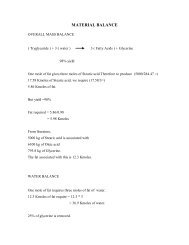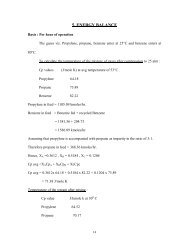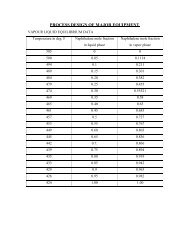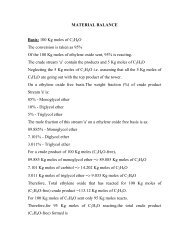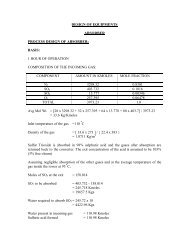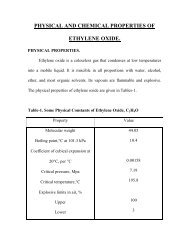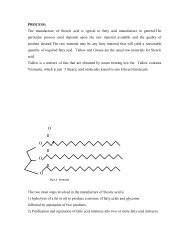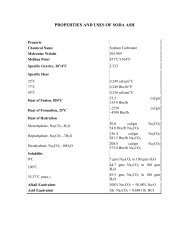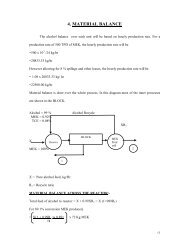Methods of Production
Methods of Production
Methods of Production
You also want an ePaper? Increase the reach of your titles
YUMPU automatically turns print PDFs into web optimized ePapers that Google loves.
COMMERCIAL PROCESSESNaphthalene is produced by the following processes:1. Recovery from coal tar2. From petroleumUnidak processHydeal processProcess given by faith1. Recovery from coal tar:The tar acid-free chemical oil is charged to the system where most <strong>of</strong> the lowboiling components, e.g., benzene, xylene, and toluene, are removed in the light-solventcolumn. The chemical oil next is fed to the solvent column, which is operated undervacuum, where a product containing the prenaphthalene components is taken overhead.This product, which is called coal-tar naphtha or crude heavy solvent, typically has aboiling range <strong>of</strong> 130-200 0 C and is used as a general solvent and as a feed stock forhydrocarbon-resin manufacture because <strong>of</strong> its high contents <strong>of</strong> resinifiables, e.g., indeneand coumarone (see hydro carbon resins). The naphthalene – rich bottoms from thesolvent column then fed to the naphthalene column where a 78 0 C freeze –point product(78 0 C naphthalene) is produced .the naphthalene column is operated at near atmosphericpressure to avoid difficulties, e.g., naphthalene-filled vacuum jets and lines, which areinherent to vacuum, distillation <strong>of</strong> this product. A side stream, which is reach inmethylnaphthalenes, may be taken near the bottom <strong>of</strong> the naphthalene column. The crude78 0 C naphthalene that is produced by distillation is not <strong>of</strong> suitable quality for manyapplications and must be further upgraded.The main impurity in crude 78 0 C coal-tar naphthalene is sulfur, which is apresent in the form <strong>of</strong> thionaphthalene (1-3%). Methyl and dimethylnaphthalene, muchcrude coal-tar naphthalene are also presents (1-2 wt%) with lesser amount <strong>of</strong> indene,methylindenes, tar acids, entire bases.
2. From petroleum:Unidak process:In the unidak process (Union Oil Company <strong>of</strong> California),the feed, which may becatalytic reformat bottoms, enters a fractionators where a naphthalene concentrate, amiddle product <strong>of</strong> alkylnaphthalenes which is treated further, and a small amount <strong>of</strong>bottom which is used fuel oil are produced. The alkylnaphthalenes which are mixed withmake-up hydrogenate 3.5 Mpa (500 psig) and some water to moderate the reaction, aretransferred to a fixed-bed reactor. The reaction product enters a high-pressure separatorwhere 80-wt% hydrogen is evolved and recycled. Low-pressure separator releases a smallamount <strong>of</strong> fuel gas and the dealkylated product is sent to the feed. The naphthaleneconcentrate is purified from a by-product which can be used is gasoline.Hydeal process:The hydeal process (Universal Oil Product) a feedstock which is derived fromheavy reformat a processed with excess hydrogen over a chromia-alumina catalyst <strong>of</strong>high purity and low sodium content. Naphthalene is recovered by distillation aftertreatment with clay to remove traces <strong>of</strong> olefins.A typical process <strong>of</strong> producing naphthalene from petroleum is given by Faith.Reaction (typical):C 10 H 6 (CH 3 ) 2 + 2H2C10H8 +2CH4Utilities Requirements (typical):BASIS: 50million pounds Naphthalene/YearHEAVY REFORMATE CATALYST CYCLE STOCKElectric power 420KW 630 kWFuel 40,000,000Btu/hr 90,000,000Btu/hrSteam 4,000 lb/hr 0Circulating water 900 gal/min 1,500gal/min
PROCESSNaphthalene may be produced from petroleum fractions high temperature andpressure in the presence <strong>of</strong> hydrogen, either with or without catalyst.Suitable feeds may be bottoms distilled from catalytic reformat or a narrow cutdistilled and concentrated from refractory cycle oils. For example, typical rerun bottoms(400 0 F end point) from catalytic reformat would contain 95% aromatics made up <strong>of</strong> 20-30% alkylbenzene; 10-15% naphthalene and 15-16% methylnaphthalene.A typical fluid catalytic cracking cycle oil (450-550 0 F cut) might contain50%aromatics, most <strong>of</strong> which are mono-,di- and tri-methylnaphthalenes. Beforedealkylating, this stock would have to be concentrated by extraction and desulfurized.In either case the concentrated aromatic feed would be pumped along with ahydrogen-rich gas to a demethylation reactor. Typical range <strong>of</strong> operating conditions for anoncatalytic thermal dimethylator are 150 to 1000psi, 1400 0 F, hydrogen naphthaleneratio <strong>of</strong> 3:1 to 25:1, residence time <strong>of</strong> 2 to 300seconds. The dimethylated product isquenched as it leaves to the reactor and sent to a separator from which part <strong>of</strong> thehydrogen rich gas recycled and part burnt as a fuel. The liquid product is distilled toseparate naphthalene, gasoline, and fuel oil. Some <strong>of</strong> the aromatic concentrate may berecycled.The naphthalene produced is usually better 99% pure and low in sulfur content.




